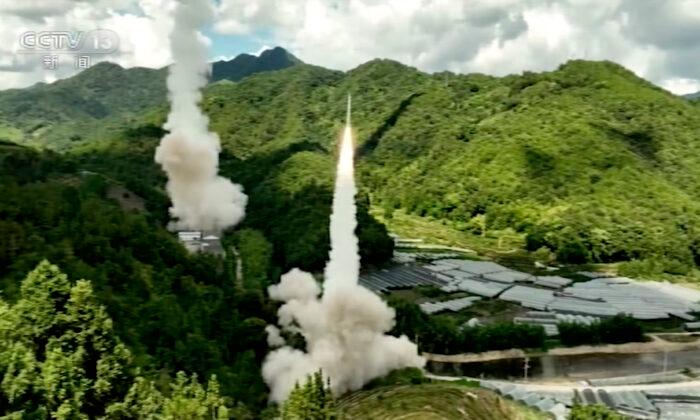North Korea has just tested a radar-guided maneuvering warhead that may also be an anti-ship ballistic missile (ASBM) warhead, which could have been made possible through indirect transfer or assistance from China.
American ships and forces in Japan and South Korea now face a much greater threat due to the failure of three U.S. presidential administrations to sanction and isolate the Chinese Communist Party (CCP) for turning this odious dictatorship into a nuclear missile state.
On Jan. 5, Pyongyang tested a new liquid-fueled ballistic missile with a maneuverable warhead—almost identical to China’s short-, medium-, and intermediate-range ballistic missiles.
Debuted at the first major North Korean weapons exhibition in early October 2021, this warhead features four fins and looks like the radar-guided and maneuverable warheads used on the Chinese DF-15B short-range, DF-16B medium-range, DF-21C, DF-21D anti-ship, and DF-26B intermediate-range anti-ship ballistic missiles.
Then on Jan. 6, the Korean Central News Agency (KCNA) provided revealing commentary on the test:
“In the test launch the academy reconfirmed the flight control and stability of the missile in the active-flight stage and assessed the performance of the new lateral movement technique applied to the detached hypersonic gliding warhead.
Having been detached after its launch, the missile made a 120 km [75 miles] lateral movement in the flight distance of the hypersonic gliding warhead from the initial launch azimuth to the target azimuth and precisely hit a set target 700 km [435 miles] away.”
This means that the maneuverable warhead departed from its ballistic arc to a lateral or flatter trajectory for 75 miles. This maneuver is similar to that performed by the Chinese DF-21D ASBM, so it can use a larger radar in the fuselage of the warhead that can pinpoint its target and make precision guidance calculations.
The North Korean maneuverable warhead is launched by a slightly smaller version of the 1,864-mile to 3,730-mile range liquid-fueled Hwasong-8 (HS-8) ballistic missile, but it’s likely to equip future North Korean solid-fuel missiles that can be launched more rapidly.
This means that North Korea now has the potential to sink large U.S. Navy warships with its precision non-nuclear missile, and can attack with precision U.S. military forces in South Korea and Japan, as well as the naval and ground forces of those countries.
Expect Pyongyang to sell this maneuverable warhead to its main allies Pakistan and Iran, creating significant new threats to Indian naval and ground bases, as well as to U.S. forces in the Persian Gulf, to Israel, and to other U.S. allies in the Middle East.
China got its head start developing ASBM technology in the 1990s, when it took over an old Soviet espionage operation that was buying in bulk the discarded scrap from U.S. Army supply depots.
Included in that scrap, apparently, were many of the excess spare parts of the U.S. Pershing-II intermediate-range ballistic missile that was armed with an innovative radar-guided warhead, which were made in excess by the U.S.-Soviet 1987 Intermediate Nuclear Forces Treaty.
China improved upon this warhead for its DF-21C precision strike-capable medium-range ballistic missile, and then developed additional modifications for its DF-21D ASBM.

It’s highly unlikely that North Korean engineers were able to replicate this development history, so one is left to consider that North Korea’s precision warhead or ASBM was provided or enabled by China—the latest in a long trail of Chinese technological assistance.
China Aerospace Science and Industry Corporation’s (CASIC) large 16-wheel transporter erector launchers (TELs) were carrying mock intercontinental ballistic missiles (ICBMs) in an April 15, 2012 Pyongyang parade.
Even though U.S. and Japanese surveillance satellites had been tracking this transfer at least for five months, “sources” in the Obama White House claimed that the transfer was merely “poor Chinese performance in sanctions implementation, but not willful proliferation,” The New York Times reported on April 19, 2012.
That CASIC TEL is now in its third generation and has grown to 18 wheels carrying the Hwasong-15. Over the last decade, other likely Chinese transfers include fourth-generation surface-to-air missile (SAM) technology, large solid fuel rocket technology, long-range land attack cruise missile technology. And on Sept. 29, 2021, China tested its hypersonic glide vehicle (HGV) warhead technology.
All along, neither the Obama, Trump, nor Biden administrations have leveled even minimal sanctions against CASIC or other Chinese companies engaged in arming North Korea in violation of numerous U.N. sanctions on Pyongyang. It seems even the United Nations has lost its voice on this threat.
Had sanctions been imposed, with additional sanctions following subsequent Chinese transfers, the process of vilifying and isolating the CCP would be much farther advanced by today. That in turn might have helped convince tragically conflicted South Korean political elites to allow the stationing of more powerful U.S. deterrent forces.
As it stands, the Chinese regime is turning North Korea into a nuclear missile state, one now armed with advanced precision and anti-ship capable ballistic missiles—which undermines the extended U.S. nuclear and conventional military deterrent and increases regional instability.
North Korea is also increasingly capable of undertaking surprise nuclear and conventional missile offensives as a prelude to a larger conventional invasion of South Korea, which if the United States sought to repel, might divert U.S. military forces sufficiently to allow China to invade Taiwan.
A promise of immediate U.S. nuclear retaliation with tactical nuclear-armed theater-range missiles and cruise missiles might help deter North Korean and Chinese aggression. But some in the Biden administration seek to constrain a U.S. “first strike” option, and the United States has no nuclear-armed theater range missiles and cruise missiles.
This diplomatic disaster has been a decade in the making. If it becomes a military tragedy, then both the Democrats and the Republicans can share in the blame—but mainly the Democrats, who are now in their second administration of failing to respond to this threat.





